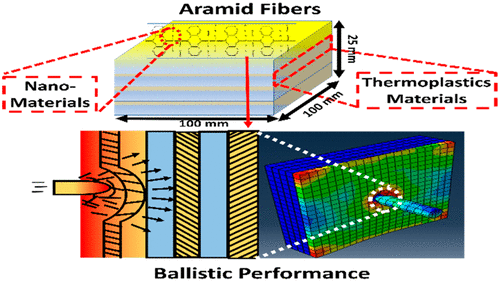当前位置:
X-MOL 学术
›
Ind. Eng. Chem. Res.
›
论文详情
Our official English website, www.x-mol.net, welcomes your
feedback! (Note: you will need to create a separate account there.)
Functionalized Aramid Fibers and Composites for Protective Applications: A Review
Industrial & Engineering Chemistry Research ( IF 3.8 ) Pub Date : 2018-11-28 , DOI: 10.1021/acs.iecr.8b04903 Prakash M. Gore 1 , Balasubramanian Kandasubramanian 1
Industrial & Engineering Chemistry Research ( IF 3.8 ) Pub Date : 2018-11-28 , DOI: 10.1021/acs.iecr.8b04903 Prakash M. Gore 1 , Balasubramanian Kandasubramanian 1
Affiliation

|
Technological growth in advanced ammunition and weapons has led to development of protective antiballistic composites, which are mostly based on aramid fibers, as they absorb high impact energy, arising from penetrators. Enhanced performance of aramid fibers (modulus ∼ 112,400 MPa) is attributed to their compact molecular structure, hydrogen-bonding, high crystallinity, and high density (∼1.44 g/cm3). Methodologies such as layer-by-layer, shear thickening, yarn pull-out, and surface functionalization via nanomaterials have been reported for modification of aramid fibers, which are widely used with thermosets like epoxy (due to process-friendliness). Recently, researchers are exploring thermoplastics with aramids, due to their higher toughness, chemical resistance, and thermal stability. Modification of aramid fibers is mostly performed using nanomaterials, e.g., carbon nanotubes, graphene, silk fibroins, SiO2, and ZnO, for enhancing their performance and minimizing fiber buckling under load. This Review presents advances in modification of aramid fibers using nanomaterials with emphasis on thermoplastics for protective applications, their stress transfer mechanisms, and life cycle analysis and concludes with their recycling/recovery methods.
中文翻译:

用于防护应用的功能化芳纶纤维和复合材料:综述
先进弹药和武器的技术发展导致了防护性防弹复合材料的开发,这些复合材料主要基于芳族聚酰胺纤维,因为它们吸收了穿透剂产生的高冲击能量。芳族聚酰胺纤维(模量〜112,400 MPa)的增强性能归因于其紧凑的分子结构,氢键,高结晶度和高密度(〜1.44 g / cm 3))。据报导,诸如通过纳米材料的逐层,剪切增稠,拉出纱线和通过纳米材料进行表面官能化的方法用于改性芳族聚酰胺纤维,该芳族聚酰胺纤维广泛用于热固性材料,例如环氧树脂(由于工艺友好性)。最近,研究人员正在探索具有芳族聚酰胺的热塑性塑料,因为它们具有更高的韧性,耐化学性和热稳定性。芳族聚酰胺纤维的改性主要使用纳米材料进行,例如碳纳米管,石墨烯,丝素蛋白,SiO 2和ZnO,以增强其性能并最大程度地减少负载下的纤维屈曲。这篇综述介绍了使用纳米材料改性芳纶纤维的进展,重点是用于保护性应用的热塑性塑料,它们的应力传递机制和生命周期分析,并以其回收/回收方法作了总结。
更新日期:2018-11-29
中文翻译:

用于防护应用的功能化芳纶纤维和复合材料:综述
先进弹药和武器的技术发展导致了防护性防弹复合材料的开发,这些复合材料主要基于芳族聚酰胺纤维,因为它们吸收了穿透剂产生的高冲击能量。芳族聚酰胺纤维(模量〜112,400 MPa)的增强性能归因于其紧凑的分子结构,氢键,高结晶度和高密度(〜1.44 g / cm 3))。据报导,诸如通过纳米材料的逐层,剪切增稠,拉出纱线和通过纳米材料进行表面官能化的方法用于改性芳族聚酰胺纤维,该芳族聚酰胺纤维广泛用于热固性材料,例如环氧树脂(由于工艺友好性)。最近,研究人员正在探索具有芳族聚酰胺的热塑性塑料,因为它们具有更高的韧性,耐化学性和热稳定性。芳族聚酰胺纤维的改性主要使用纳米材料进行,例如碳纳米管,石墨烯,丝素蛋白,SiO 2和ZnO,以增强其性能并最大程度地减少负载下的纤维屈曲。这篇综述介绍了使用纳米材料改性芳纶纤维的进展,重点是用于保护性应用的热塑性塑料,它们的应力传递机制和生命周期分析,并以其回收/回收方法作了总结。































 京公网安备 11010802027423号
京公网安备 11010802027423号